 Album
|
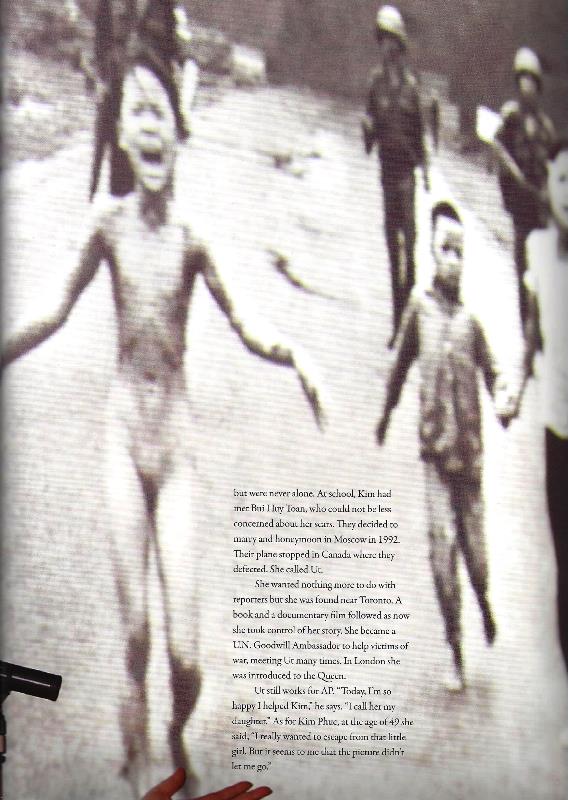 Tôi muốn chạy trốn bức
hình, chạy trốn đứa con nít trong bức hình đó,
nhưng nó... dai như đỉa!
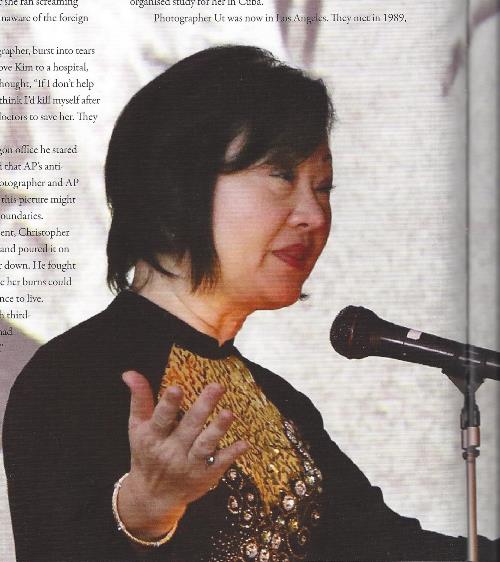 Napalm Girl
The photo took just a second, but it is timeless. She races towards the
reader on countless front pages, a little girl in torment.
Nine-year-old Kim Phuc, flees down a highway after napalm bombing.
Associated Press photographer Huynh Cong Ut not only took the photo,
but it also changed his life and that of Kim's. June 8 1972 and Kim hears a soldier screaming, "We have to run out of this place! They will bomb here and we will be dead!" Yellow and purple smoke bombs wreathed a temple where her family took refuge for three days while North and South Vietnamese forces battled over their village. Kim watched a South Vietnamese Skyraider swoop towards her. Canisters tumbled from it, twisting end over end to evaporate on the ground in unbearable orange flames that leapt onto her left arm as her cotton clothes shredded. The pain seared her skin and muscle. Nearby trees exploded and the ground shook. Kim's first thought as she brushed her blisters with her right arm was, "I will be ugly, and I'm not normal any more. People will see me in a different way." As shock took over she ran screaming down Highway 1 behind her older brother, unaware of the foreign journalists in front of her. She passed out. Ut, the 21-year-old Vietnamese photographer, burst into tears at the sight and took the picture. He then drove Kim to a hospital, where he was told she was beyond help. He thought, "If I don't help her - if something happened and she died - I think I'd kill myself after that." Using his US. press pass, he implored doctors to save her. They agreed. Developing his film in the agency's Saigon office he stared at the naked little girl. His colleagues worried that AP's anti-nudity policy would kill it. But legendary photographer and AP photo editor Horst Faas could see that while this picture might break the rules its impact transcended such boundaries. A couple of days later a TV correspondent, Christopher Wain, who gave Kim water from his canteen and poured it on her burning back on the highway, tracked her down. He fought to have her moved to an American unit where her burns could be properly treated and she would have a chance to live. Thirty percent of her body was raw third-degree burns, but her face was unscathed. “I had no idea where I was or what happened to she said. "I woke up and I was in the hospital with so much pain, and then the nurses were around me." Her ordeal worsened. At 8 am each day nurses had to put her into a bath to cut off her dead skin. She fainted with pain. Thirteen months and countless operations and skin grafts later she could leave hospital. She wanted to go home. She had been shown the photo and knew Ut had won the Pulitzer Prize. Kim moved to a small village near the Cambodian border, occasionally visited by Ut and other journalists. Once South Vietnam came under northern control in April 1975 life became harder for her. Painkillers and even treatment cost too much. Shocking headaches and pain filled her teenage years. She set herself on a path to become a doctor but was plucked out by the government as a propaganda tool and returned to her home province. Her interviews were scripted. "I wanted to escape that picture:' she said. "I got burned by napalm, andI became a victim of war ... but growing up then, I became another kind of victim." She began to wish she died in the bombing, with her cousin and South Vietnamese soldiers. A journey West Germany in 1982 for medical care with the help of a foreign journalist began to change her life. Vietnam's Prime Minister was touched by her ordeal and organised study for her in Cuba. Photographer Ut was now in Los Angeles. They met in 1989, but were never alone. At school, Kim had met Bui Huy Toan, who could not be less concerned about her scars. They decided to marry and honeymoon in Moscow in 1992. Their plane stopped in Canada where they defected. She called Ut. She wanted nothing more to do with reporters but she was found near Toronto. A book and a documentary film followed as now she took control of her story. She became a U.N. Goodwill Ambassador to help victims of war, meeting Ut many times. In London she was introduced to the Queen. Ut still works for AP. "Today, I'm so happy I helped Kim;' he says."I call her my daughter." As for Kim Phuc, at the age of 49 she said, "I really wanted to escape from that little girl. But it seems to me that the picture didn't let me go." 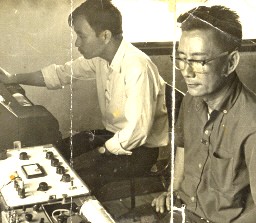 Cái hình GCC
ngồi gửi hình cho UPI, tay trái chưa cử động OK, vì mìn VC mà chẳng
bảnh sao?
Note: Từ cái khung cửa sổ kế bên Gấu, nhìn ra, bữa đó, Gấu nhìn thấy cảnh trực thăng bắn rốc kết xuống vùng Trảng Bàng, và ít giờ sau đó, nhân viên AP mang bức hình Kim Phúc lên Đài, để chuyển đi bằng phương pháp VTD. Trạm nhận đầu tiên là văn phòng AP tại Tokyo. Các binh sĩ lực lượng Nam Việt Nam chạy theo nhóm trẻ em sợ hãi, (Bé gái 9 tuổi Kim Phúc ở giữa trái),khi chúng chạy xuống lộ 1 gần Trảng Bàng sau một cuộc tấn công bằng bom napalm trên không vào nơi bị nghi ngờ cất giấu lực lượng Bắc Việt Nam, ngày 08 tháng 6, năm 1972. Một máy bay của Nam Việt Nam đã thả bom nhầm vào làng có quân đội và người dân miền Nam Việt Nam. Bé gái trần truồng do gạt bỏ áo quần bốc lửa trong khi bỏ chạy. Các trẻ em từ trái sang phải là: Phan Thanh Tâm, em trai của Kim Phúc, người đã bị mất một mắt, Phan Thanh Phước em trai của Kim Phúc, Kim Phúc, và anh em họ của Kim Phúc là Hồ Văn Bon, và Hồ Thị Ting. Đằng sau họ là những binh sĩ của Sư đoàn 25 quân đội Nam Việt Nam. (Ảnh AP / Nick Út) ![[IMG]](http://i603.photobucket.com/albums/tt113/PATVN/vietnam%20war/v31_06080512.jpg) (Hình3/3) Các phóng viên và binh sĩ và quân đội miền Nam Việt Nam vây quanh sơ cứu cho bé Kim Phúc 9 tuổi trên đường 1 gần Trảng Bàng sau khi cô bị đốt cháy bởi một cuộc tấn công bằng bomb napalm, ngày 8 tháng 6 1972. Một máy bay của quân đội Nam Việt Nam đã thả bomb nhầm mục tiêu vào một ngôi làng ở vùng này. (AP Photo / Nick Út) ![[IMG]](http://i603.photobucket.com/albums/tt113/PATVN/vietnam%20war/v32_06080116.jpg) P/s : chị Kim Phúc hiện đang định cư tại Canada. Phóng viên Nick Út thời gian qua cũng trở lại Việt Nam nhiều lần và tham gia hiều khóa đào tạo phóng viên ảnh cho các báo Việt Nam (1) 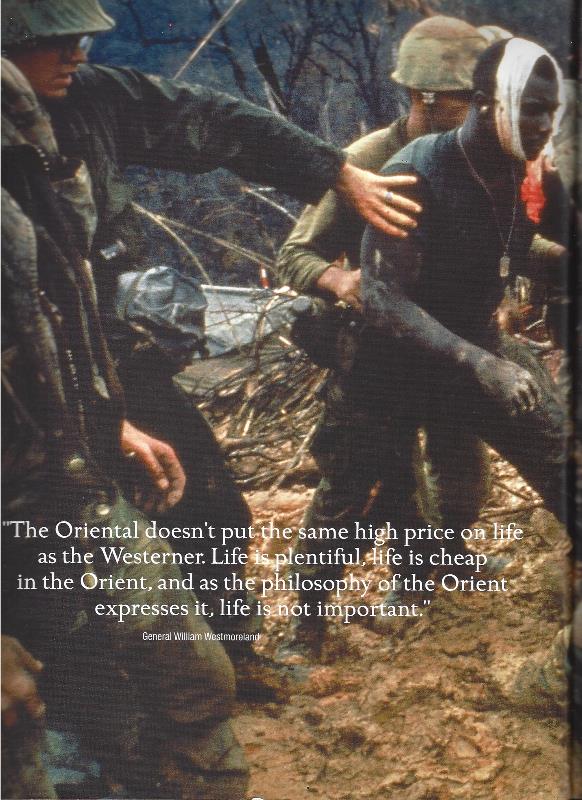 Lũ Bắc Kít
coi mạng người rẻ lắm. Mà người ở đó nhiều lắm, rẻ như bèo. Tướng Mẽo
lập lại lời
Lê Duẩn, Võ Tướng Quân. 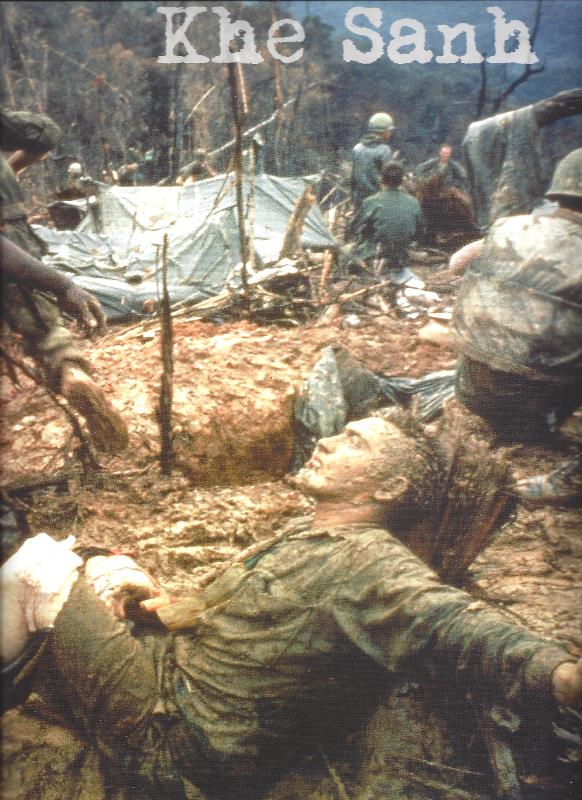 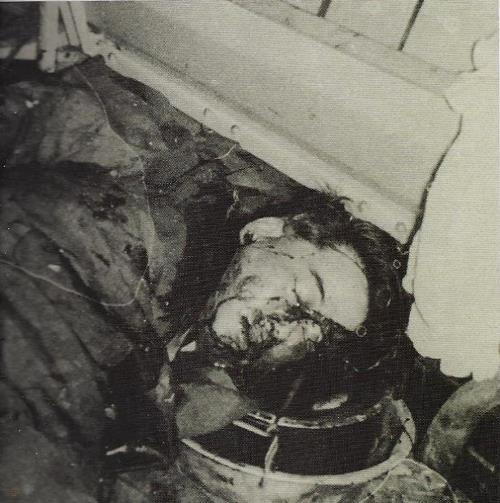
It doesn't
sound like much now, but $40,000 from the CIA meant the end of Ngo Dinh
Diem as
leader of South Vietnam. The cash went to some of his generals, with
the
undertaking that the US would not oppose their brutal takeover. That month the U.S. ambassador to South Vietnam, Henry Cabot Lodge, flew into Saigon to tell Diem: "I want you to be successful. I want to be useful to you. I don't expect you to be a 'yes man: I realize that you must never appear a puppet of the United States." Lodge said Diem also had to realize American public opinion had turned against him. Lodge said the U.S. favored religious tolerance. Diem's policies were "threatening American support of Vietnam': Diem had to set his house in order by removing Ngo Dinh Nhu, silencing the outspoken Madame Nhu, punishing those responsible for the massacre in Hue and coming to terms with the Buddhists. Washington was no longer prepared to support his regime unconditionally. Lodge was ignored and Diem began to be seen as an obstacle in efforts to unite the South Vietnamese against communism. President Kennedy withdrew CIA protection. The generals moved early in November, 1963. The plotters promised Diem that he would be allowed to leave the country but changed their minds and killed him. He was 62 and had paved the way for the war to come. Bốn chục
ngàn đô. Bây giờ thì chẳng đáng gì, nhưng đó là số tiền Xịa chi cho lũ
tướng
lãnh Ngụy để làm thịt ông. Đến bây giờ, chúng vẫn xử dụng đòn này, khi cần làm thịt dân Mít, những ai đòi hỏi dân chủ. Khi ra lệnh giết Phạm
Quỳnh, cũng là lúc bác Hồ ngồi vô bàn viết, thảo
cái giấy, sau này đưa cho con cái của PQ, ngày sau lịch sử sẽ minh oan
cho cha
cháu! Hà, hà! Thằng em
trai của Gấu, chết lãng nhách, vì 1 viên đạn, trong cả băng AK, bắn từ
bên kia sông,
xuống sông, rồi viên đạn, theo luật khúc xạ chui ra khỏi mặt nước, bay
tới nằm
sau ót cu cậu. Một viên đạn hết đà, giả như đụng bất cứ 1 chỗ nào, thì
chỉ làm
trầy da. Kennedy chết,
ngược lại. Do bịnh, ngồi xe trần, ngồi thẳng được là nhờ 1 cái giá, 1
thứ “back-brace”,
như Christopher Hitchens cho biết. Chính vì thế, ông không làm sao xoay
sở,
phản xạ
phản xiệc, khi nghe tiếng súng, và đành ngồi chết trân hứng viên
đạn! Diệm chết, đúng
như Gấu phán, mi làm bồi Mẽo, Mẽo ra lịnh sao, phải làm theo, đéo làm
theo, là ông
xịt! Không có Tẫu đếch có Ngụy! Hà, hà!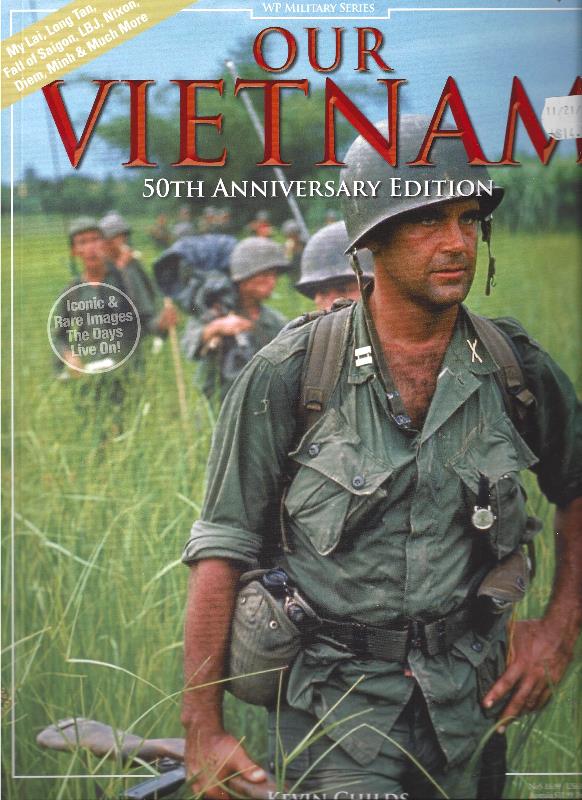 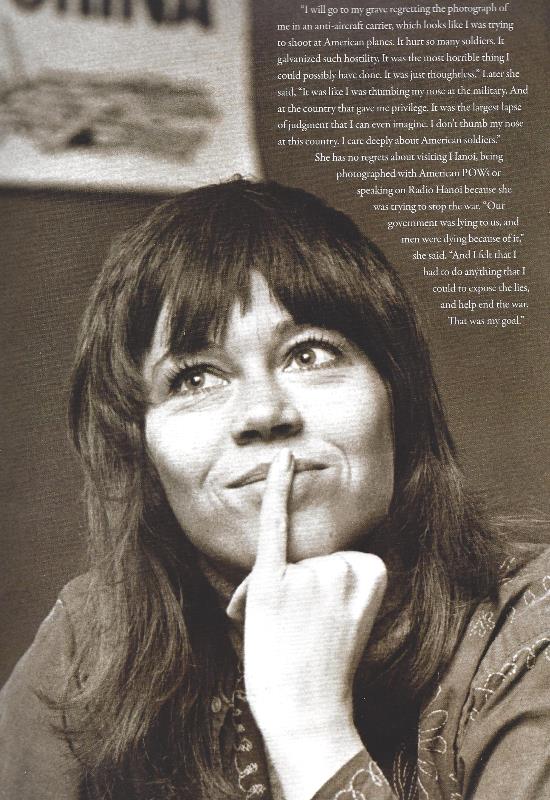 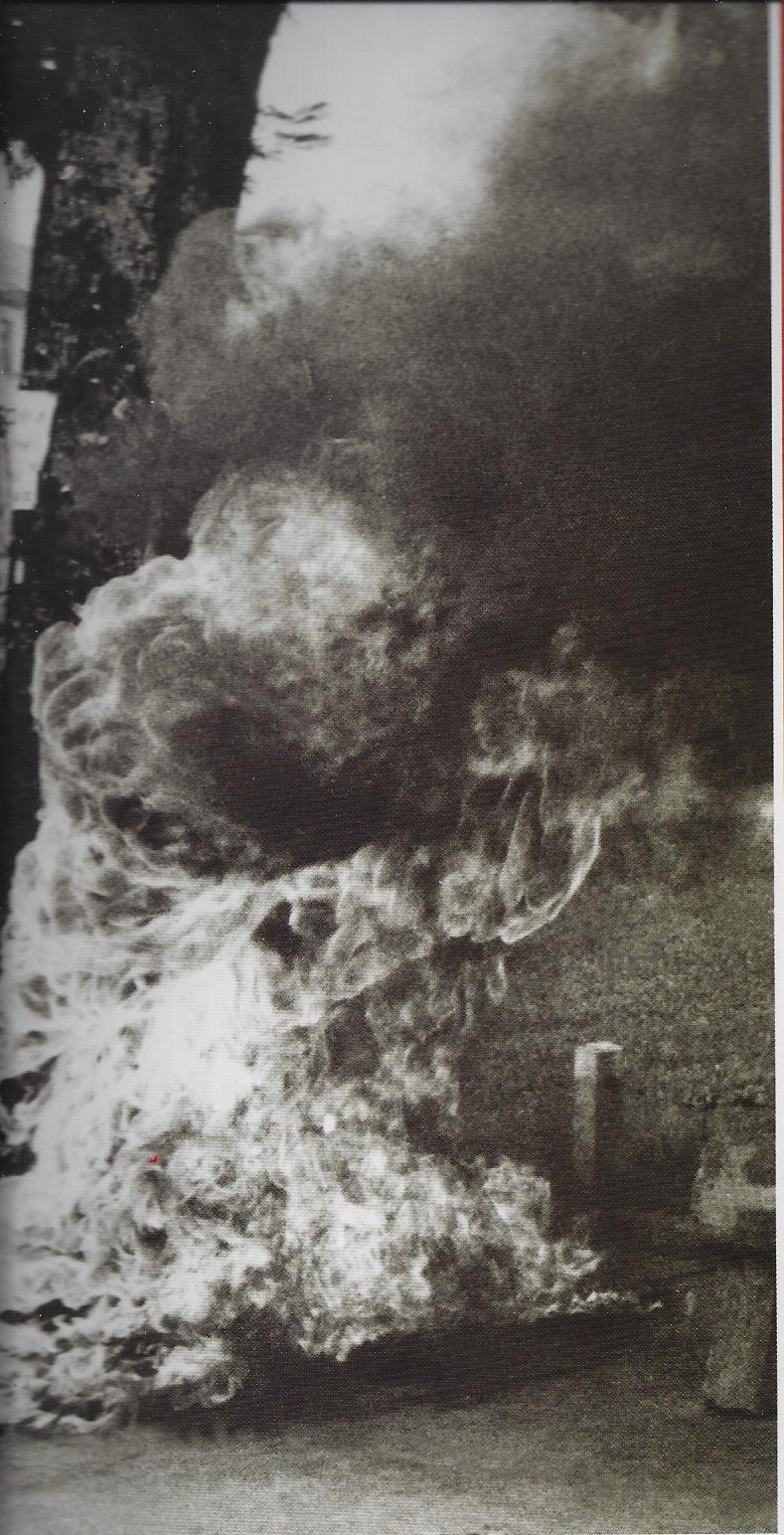  Ngo Dinh Diem His greatest
trick was to follow. In October, 1955, the South Vietnamese people had
to
choose between Bo Dai, the former Emperor of Vietnam, and Diem for the
leadership of the country. The plan was to have two ballot papers, red
for Diem
and green for Bao Dai. It was thought the Vietnamese belief that red
signified
good luck while green meant bad fortune, would influence the vote. But
at the
polling stations Diem's backers told voters to put the red ballot into
envelopes and discard the green ones. Those who defied the order were
beaten
up, some to pulp. Diem told his American advisors he had 98.2 per cent
of the vote.
They suggested about 70 per cent would be a better figure, but he
refused and
so the election vaporized his authority. Then the North Vietnamese
government
reminded Diem that under the Geneva Agreement a General Election for
the whole
of the country was due in July, 1956. Refusing to accept this, he began
rounding up his opponents and before long about 100,000 people were in
prison
camps, including communists, socialists, journalists, trade unionists
and
religious leaders. Children caught writing anti- Diem graffiti on walls
were
jailed. The realisation that Diem would ignore the agreement led to
many people
joining guerilla groups in the forests. Attacks on Diem's bureaucrats
began,
with an estimated 1200 killed in 1959. That year his government began a
massive
resettlement program, forcing peasants in small villages or isolated
areas,
often at gunpoint, to move to populated areas under government control.
By the
early 1960s there were more than two dozen of these 'Agrovilles' each
with
several thousand peasants. Massive social a economic disruption ensued,
with
families torn apart, taken fro the countryside they knew and away from
their
sacred sites, such as temples
and ancestral graves. Most ''Agrovilles'' were not big enough for
everyone to
get plots or even to farm. Catholics like Diem were privileged under
the
French, despite the country being about 70 per cent Buddhist. Diem kep
the
anti-Buddhist laws passed by the French. This began a tragic train of
events.
On May 8, 1963, Buddhists in the magnificent ancient city of Hue marked
the
2,527th birthday of the Buddha. Police fired into a crowd, killing a
fleeing
woman and eight The impassioned response of the Buddhists made front
pages around
the world. On June 11, 1963, Thich Quang Duc, a 66- year old monk, sat
in the
middle of a busy Saigon road amid monks and nuns. They poured petrol on
his
head and set him on fire. "As he burned he never moved a muscle;' said
a
witness, "never uttered a sound, his outward composure in sharp
contrast
to the wailing people around him." Diem's government's jailed thousands
of
monks, many of whom just vanished. Within two months five more monks
burnt themselves
to death. Said a member of the South
Vietnamese government: "Let them burn and we shall clap our hands."
Another
offered Buddhists petrol. That month the U.S. ambassador to South
Vietnam,
Henry Cabot Lodge, flew into Saigon to tell Diem: "I want you to be
successful.
I want to be useful to you. I don't expect you to be a 'yes man: I
realize that
you must never appear a puppet of the United States." Lodge said Diem
also
had to realize American public opinion had turned against him. Lodge
said the
U.S. favored religious tolerance. Diem's policies were "threatening
American support of Vietnam': Diem had to set his house in order by
removing
Ngo Dinh Nhu, silencing the outspoken Madame Nhu, punishing those
responsible
for the massacre in Hue and coming to terms with the Buddhists.
Washington was
no longer prepared to support his regime unconditionally. Lodge was
ignored and
Diem began to be seen as an obstacle in efforts to unite the South
Vietnamese
against communism. President Kennedy withdrew CIA protection. The
generals
moved early in November, 1963. The plotters promised Diem that he would
be
allowed to leave the country but changed their minds and killed him. He
was 62
and had paved the way for the war to come.Thằng em
trai của Gấu, chết lãng nhách, vì 1 viên đạn, trong cả băng AK, bắn từ
kia kia sông,
xuống sông, rồi viên đạn, theo luật khúc xạ chui ra khỏi mặt nước, bay
tới nằm
sau ót cu cậu. Một viên đạn hết đà, giả như đụng bất cứ 1 chỗ nào, thì
chỉ làm
trầy da. Kennedy chết,
ngược lại. Do bịnh, ngồi xe trần, ngồi thẳng được là do 1 cái giá, 1
thứ “back-brace”,
như C. Christopher cho biết. Chính vì thế, ông không làm sao xoay sở,
phản xạ
phản xiệc, thua, khi nghe tiếng súng, và đành ngồi chết trân hứng viên
đạn! Diệm chết, đúng
như Gấu phán, mi làm bồi Mẽo, Mẽo ra lịnh sao, phải làm theo, đéo làm
theo, là ông
xịt! Bài viết trên tờ “Our Viet Nam”, cho biết, Mẽo ra lệnh khử vợ
chồng Nhu, làm
sao khử, thế là xong đời Diệm. Những gia thoại, về Nhu cho người ra
Bắc, gặp Bác
Hồ này nọ, theo Gấu, có thể có, vì cái chuyện Diệm không muốn GI vô
Việt Nam là
có thiệt, ông chết vì cú này, mới đúng. Trong số báo TV mới mang về, có
bài viết
về liên hệ giữa Tẫu và Bắc Kít, cho thấy, không có Tẫu, là Mít thoát cả
hai cuộc
chiến. Điều này cũng
dễ đoán, Bắc Kít phải lệ thuộc Tẫu tới cỡ nào thì mới răm rắp nghe theo
Tẫu khi
chúng ra lệnh phát động cuộc Cái Cách Ruộng Đất. Chính nhờ nó, phát
động sớm, mà
có vụ di cư. Ngụy phải cám ơn Tẫu, không chỉ một, mà hai lần, vụ di cư
và vụ tù
cải tạo. Không có Tẫu đếch có Ngụy! Hà, hà! |